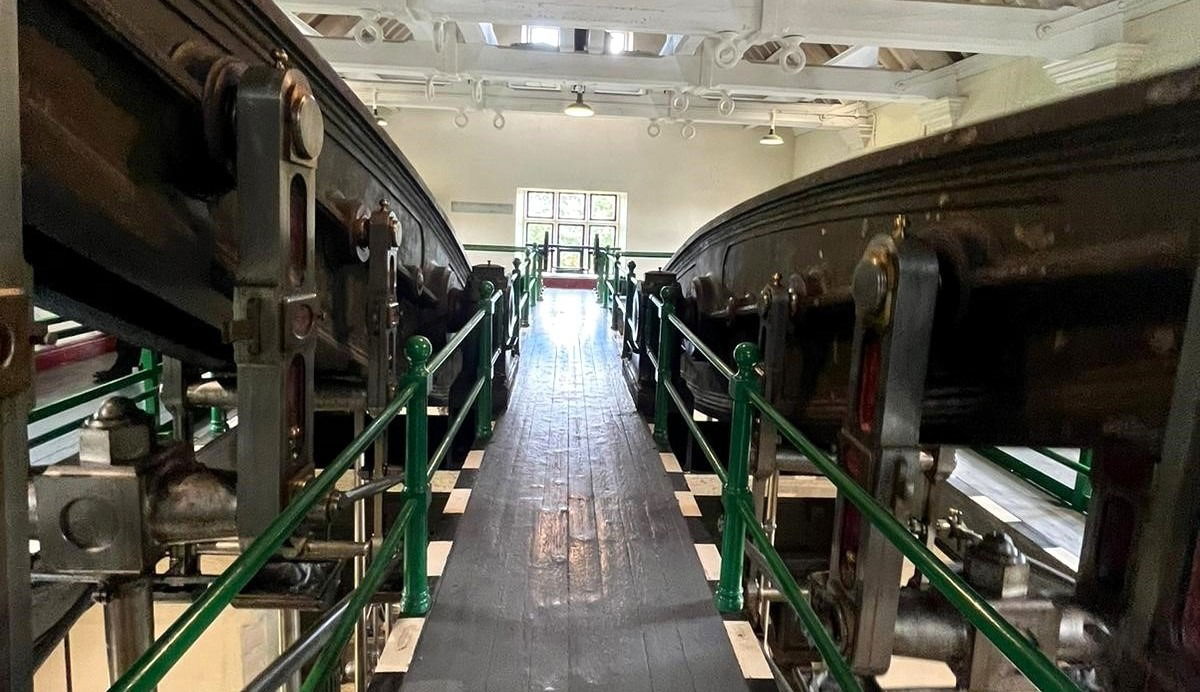Ryhope Engines Museum
Museum In Sunderland, Tyne And Wear
An original working Victorian Water Pumping Station operated by steam.
If ever you are wondering what to do on a Steam Day? Give Ryhope Engines Museum a visit as the pumping station will be in operation.

There is a pleasing vista from the gates that shows this magnificent gothic-looking structure which was apparently built as a temple to industrial achievement (My brother-in-law's term).
It has 2 badges being Grade II listed and an Ancient Scheduled Monument. I will tell you nothing of how this works, but give snapshots of various aspects.

In the mid-1800s water supply was being radically changed as demand grew from industries and purity for consumption was much needed. Cholera outbreaks and other illnesses caused by unhygienic water were one of the biggest killers of adults of these times.
Water companies formed and in 1852 Sunderland and South Shields Water Company sprung up.
Coal mining had determined that there was water in the magnesian limestone aquifers (try saying that twice!)

The 4 acres at Ryhope seemed the perfect place to build a Pumping Station but the price of the land was prohibitive. The builders looked elsewhere but nowhere else seemed suitable so they struck a deal and purchased this land.
The water companies tended to build the stations 2 miles apart as a pragmatic rule, so that there was an even spread over the magnesian limestone.

This pumping station was built circa 1866 to 1868 and it was to supply the Sunderland area with water that was pumped up from the magnesian limestone holding the fresh rainwater. The water was 250 feet down so two wells were built within the pumping station (See photo taken from information in the station).
This water was distributed untreated. Such was the success that in 1905, 8 million gallons of water a day were being pumped through 350 miles of pipework to supply the area. That's 123 public swimming pools and the distance from Newcastle to Brighton.



Built in red brick with long windows, the gothic feel is partly due to that the bricks and mortar have discoloured with grime from coal and smoke. Also some of my photos were taken on a rainy day.
There is much to marvel at including the sturdiness of the wall buttresses, the Dutch architectural influence, with curving gables. The spired ventilator in the middle of the roof is eye-catching.
There are 2 cooling ponds and a covered reservoir that still serves the area today. It has been suggested the reservoir was covered as the trees shedding their leaves was a problem. What a thing to do instead of cutting the planted trees down! There were also flower gardens and lawns.



The building had to be sound in order to contain all the machinery such as furnaces, boilers, flywheels, governors, and pump rods.
The governors use centrifugal force and this is where the expression 'running balls out' (thanks Phil Sargent) comes from.
The builders, machine makers, engineers, fitters, and subsequent operators are a testament to such a good fit-out that Ryhope ran for 100 years continuously. Only a few alterations (such as furnaces) minor repairs and maintenance were required.
Look out for the oil cans for pieces of equipment. This is to gauge how much a machine is using and how different machines would have different types of oil. You can smell this in the air. I for one find the smell evocative as my dad had a workshop (he was a Farmer) and it smelled the same.





Now, the chimney can be seen for miles. It is almost 160 feet of tapered red brick and is octagonal in design. The bottom had a substantial plinth and the top has a prominent cornice.
A steeple jack went up in 1970 and stated that the structure was still sound.
It has a few repairs and the very top ornate iron crested work suffered from the smoke acids and weather (being near to the coast), so has been replaced with lighter work. You may wonder like I did how the smoke goes up the chimney as it is not visibly connected to the main building. Well, it goes underground. The furnaces are actually below ground level and the chimney has to be tall, so that it draws the smoke out with the aid of flues that are controlled by weighted pulleys in the furnace area.


When you get to the top of the main building, look at those whooping beams! You can't get them in a photo in one piece. There are photos on the wall that show how the two top beams were installed. When they put the roof on, the designers were forward thinking as to insert big hooks, so that should the need ever arise the beams could be lifted.

The beam engines have the capability of 100 horsepower. What is a horsepower you may ask? Here's a diagram, courtesy of Wikipedia.

In the 1920s and 1930s, signs were that the extraction from the magnesian limestone was reaching its limit. Private pumping stations and wells were springing up and the people doing this were not doing everything by the book. Another problem was as they were near the sea the brackish (salt) water could infiltrate.

Many pumping stations had been converted to electric, but not Ryhope as it was still going well under steam power.
Ryhope Coal Mining Company wanted the coal below the station and in 1943 got it using bord and pillar methods (I had to look that up). here's a diagram coursry of Te Rra (Enclopedia of New Zealand)

As far as I can work out the water at Ryhope was never treated. The demise of the station came with the advent of two freshwater reservoirs Derwent and Kielder. Fresh water was softer, tasted nicer, and was not as prone to leaving mineral deposits, so kettles and washing machines didn't scale up. Also, the amount of water required was wiping them out and so the station eventually closed in 1967.

If you have an enquiring mind and want to know how it all works, visit on a steam day and ask the volunteers who are super knowledgeable and helpful.
Thanks to Charlie for some extra photos of the inside and furnace roaring away.
Get 2 points if you have visited this place. Already visited by 78 VIPs.
Login to the VIP area to add places to your bucket list, mark them as visited and more importantly see where you rank on the league table.
How To Find Ryhope Engines Museum
Where Is Ryhope Engines Museum?
Lat / Long
54.865284, -1.372258
What three words
Where To Park For Ryhope Engines Museum?
Lat / Long
54.865284, -1.372258
What three words
Lots of parking on site.
Contributed by Rosalind Parker
Thank you for reading. I hope it sparks your interest. It’s always a pleasure to get out and explore, whatever the weather. I enjoy uncovering little snippets of information, especially when they’re obscure, amusing, or meaningful. All photos were taken on a mobile phone.
More Places from Rosalind
More Places In Sunderland
Find more fabulous places in Sunderland, Tyne And Wear and if you know of a place we haven't listed, then let us know.

Penshaw Monument
Building Sunderland Tyne And WearA memorial in the style of an ancient Greek temple on Penshaw Hill owned by the National Trust.

River Wear Lime Kilns
Lime Kiln Sunderland Tyne And Wear19th century lime kilns, located on the River Wear.

Shadows In Another Light
Art Sunderland Tyne And WearArtwork of a steel tree that stands at the location of an actual riverside crane.
More Museums
So this museum wasn't enough and you want more? Don't worry we have you covered.

Sunderland Museum And Winter Gardens
Museum Sunderland Tyne And WearSomething for all ages, from dinosaurs to mining, shipbuilding, glass, art, natural history, and an arboretum!

Preston Park Museum And Grounds
Museum Stockton on Tees North YorkshireA former gentleman’s Georgian residence and now a museum in a park nestled along the river Tees.

Locomotion
Museum Bishop Auckland County DurhamLocomotion in Shildon is a captivating railway museum that showcases the history of locomotives and their impact on transportation.
Never Miss A Fabulous Place
If you are afraid of missing out on all the fabulous places we post, or just want to be the first to know, then sign up to the Fabulous North.
Each week we will email you all the brand new places that we visit.
Sign Up To AlertsFind Us On Facebook
We post all our new places daily on our Facebook Groups page, so join the group today and be notified when we add a new place.
Join Our Facebook GroupRyhope Engines Museum was listed in Museum // Tyne And Wear // Sunderland

